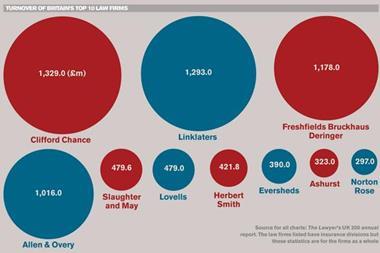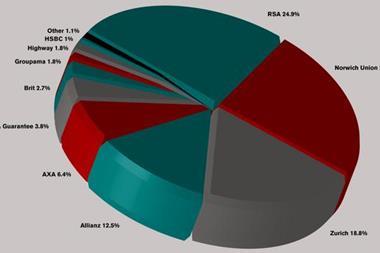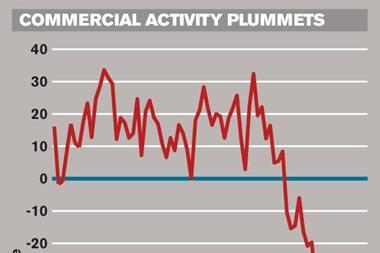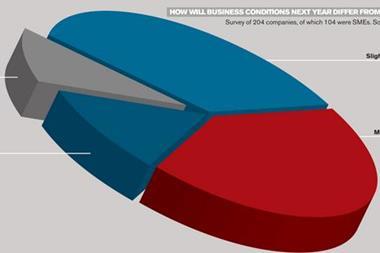Claims and premiums are rising
Overview
You don’t have to be an actuary to see that the claims ratio for the 2009 management liability market is looking scary, writes Lauren MacGillivray.
The UK’s business liability market is about $3.5bn (£2.4bn), including inward premiums from Europe, the USA and Asia. But with claims on the rise, particularly for directors’ and officers’ (D&O) and errors and omissions (E&O) policies, the estimate for global subprime losses is a whopping $12bn.
On top of that, losses connected with Bernard Madoff’s alleged fraud have been forecast at up to $3.8bn. So, depending on how all the litigation in the USA and elsewhere pans out, business liability premiums could end up looking like pocket change compared with payouts.
The good news for insurers is that their exposure in the Madoff affair is expected to remain limited (box, right). But as the downturn continues, liability claims are bound to spiral.
“When margins get tighter, things that you would have let ride turn into disputes,” says Nigel Brook, a partner at Clyde & Co, an international law firm in London. “Very often, companies that have their back against the wall feel they have little option but to litigate things [to get a payout any way they can].
“Then at the insurance level, a lot of these people who are sued will have liability insurance.”
So far, US disputes have dominated headlines (see charts). But the effects could be pandemic ...
Bernard Madoff and the European insurers
A Ponzi (pyramid) scheme generally pays investors with money from other investors. New York financier Bernard Madoff’s alleged pyramid scam was worth $50bn (£35bn), meaning about $25bn in cash would have had to be available to pay half the investors.
“It’s difficult at this early juncture to imagine a number like that, and then imagine how much will be sued for and how much is insured,” says Greg Flood, president of IronPro, the professional liability arm of Bermuda-based insurance group Ironshore Inc.
“However, if you take just 4% of the total damages being recoverable, that’s $1bn. And knowing that there are 8,000 individuals and institutions allegedly defrauded, you only need a small proportion of them to be hedge funds, fund of funds, investment advisory activities, or investment manager activities of large banks. Most of those carry insurance, as well as accountants and lawyers who might have been advising their clients.”
He says many charities also claim they have been fleeced.
The alleged scam has unleashed a host of potential claims, with celebrities such as Hollywood director/producer Steven Spielberg and actor Kevin Bacon and his wife Kyra Sedgwick reported to be among the victims. It has also been reported that UK investors are planning to sue HSBC, Barclays, UBS and Nicola Horlick’s Bramdean fund.
But according to a JP Morgan report released in mid-December, European insurers have limited exposure.
Swiss Life was found to have the most significant exposure at CHF90m (£55m), due to fund of funds exposure. The only other significant finding concerned AXA, which has less than €100m (£92m) exposure – both direct and indirect.
“We think it encouraging that the exposures are small and it supports our view that the insurance sector has significantly improved risk management since its crisis in 2001-03,” the JP Morgan report said.
“Even the banking operations of ING did not have significant exposure, in contrast to others in the banking world.”
However, business liability claims remain a big threat and insurance exposures are still being worked out. As reported in Insurance Times, specialists have estimated that Madoff-related claims on directors’ and officers’ (D&O) and errors and omissions (E&O) policies will range from $760m (£525m) to $3.8bn.
Flood says: “We’re hearing that the big banks, the Wall Street banks by and large, didn’t put funds into Madoff. Only the medium and smaller banks and institutions did.
“It seems [the Wall Street banks] had various criteria that they apply and he just didn’t meet those criteria. So this could be troublesome ... it will expose D&O and E&O insurers.”
However, Paul Towler, a partner at insurance broker and risk consultant Jardine Lloyd Thompson, says: “A range of insurance cover is available to protect firms and their clients from incidents such as this; however, the worry is whether they have sufficient limits and the right type of insurance that will protect their clients.”
Suing Madoff’s US vehicles is unlikely to be worthwhile because they have no money. But insurers should be wary if they cover third parties involved in advising, administering, auditing or selling Madoff funds and their feeders.
According to a Lloyd’s spokesman, it has not found any exposure to Madoff so far. But he says potential claims include professional indemnity claims against banks and asset managers who provided advice to institutional and retail investors.
Will irate shareholders sue financial institutions?
While the Madoff scandal has grabbed the limelight, the rise in business liability litigation is a direct result of the credit crunch.
“Any company that’s seen a sharp drop in its share price has prompted legal action by stock and bond holders ... This seems to happen almost as a matter of course now,” says Nigel Brook, a partner with the law firm Clyde & Co.
Take Fortis, for example, the Belgian-Dutch financial services group. As Insurance Times went to press, Reuters reported that FortisEffect, which represents about 10,000 shareholders, bonds and options, was suing the Dutch state to reverse last October’s nationalisation of the group. FortisEffect is also seeking compensation of €10 (£9.20) per share for losses between January and June 2008.
Fortis was partially nationalised by the governments of Belgium, Luxembourg and the Netherlands in late September – with the Netherlands taking over its Dutch operations for €16.8bn. There is no direct Dutch equivalent of a US class action but, as in the UK, there are other forms of collective action.
Adam Kemal-Brooke, special counsel, solicitor and US attorney for Fishburns Solicitors in London, said in an earlier interview: “A case for compensation might be brought under Dutch laws that allow mass representative actions (whereby each shareholder files a separate lawsuit, pending a decision in one or two test cases).
“It is also possible that litigation of this kind might lead to a so-called ‘class’ settlement under the Dutch mass tort settlement legislation, allowing a Dutch court to authorise a Europe-wide settlement between all ‘class member’ shareholders and the Fortis executives.”
But many lawsuits will be bound to fail. For example, Northern Rock was the first institution in the UK to fail in the global liquidity crisis. Kemal-Brooke says that although the bank’s former management has been criticised, it is unlikely that the company – or a shareholder on its behalf – will sue former board members for compensation.
“While the actions of its former executives arguably resulted in the bank borrowing more than £30bn from the UK taxpayers to enable it to continue trading, subsequent investigations appear to have concluded that there are insufficient grounds to proceed with legal action against them,” he says.
“Although the FSA has not as yet ruled out action against individuals at Northern Rock (or any other institutions in the spotlight), it is the shareholders who have suffered losses and not the consumers the FSA primarily acts to protect.
“If the FSA is to pursue individuals for shareholder losses, there would need to be some form of market abuse or breach of the listing rules, neither of which appears to have occurred.”
Clyde & Co’s Brook says if share prices drop, many people will feel that someone is to blame.
“If these sorts of cases don’t really have a lot more to them than that, some will be struck out quite early on. But there will be others that have got legs – where it does look like the company knew for some time that it had problems before it actually hit the wall, but didn’t tell the shareholders.”
He says he has also seen disputes over share value losses due to exposure to credit default swaps or other credit-related losses. But, perhaps surprisingly, he says directors’ and officers’ (D&O) rates have not shot up as a result.
Brian Mohen, managing director of Arden Financial Services in New York, said in a release by Angel Underwriting that the D&O industry was waiting to see how the market would unfold.
With the rise in claims and an upturn in directors looking for protection, he expected the market to harden. But he said: “With AIG in particular, we are talking about one company which has 30% of the global D&O market – so there is a great deal of caution and uncertainty as we wait to see how this plays out.
“How it deals with the repayment of the bailout, whether it keeps its assets and how effectively it can unwind itself will have a major bearing on the market.”
According to Advisen, a provider of information and risk analytics to the commercial insurance industry, about 10 companies write about 80% of the financial institution D&O and errors and omissions coverage for US and foreign firms. Insurers most likely to face big claims are the biggest companies such as AIG, XL Capital, Chubb Corp, Ace and Arch Capital.
‘What’s emerged is the absence of regulation’
Meanwhile, regulators have come under fire too.
“What’s emerged is either the absence of regulation or complete fraudulent activity by people who weren’t stopped,” says Duncan Hall, senior researcher at the broker and adviser, FinnCap.
“The tendency of companies will be to try to sue the advisers and so you may see some dramatic increase in professional indemnity insurance. But I think it’s the process of regulation that is to blame.”
The US Securities and Exchange Commission and the UK’s Serious Fraud Office are investigating Bernard Madoff’s businesses.
But Hall says: “It’s like a policeman stopping children throwing chewing gum on the street when there’s murder and looting going on around the corner.”
Hosted by comedian and actor Tom Allen, 34 Gold, 23 Silver and 22 Bronze awards were handed out across an amazing 34 categories recognising brilliance and innovation right across the breadth of UK general insurance.














































No comments yet